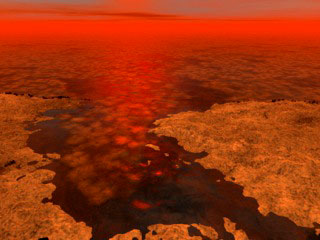Cassini suggests ice floats on a Saturn moon
By Susan Kelley

It's not exactly icing on a cake, but it could be icing on a lake.
A new paper, by a Cornell astronomy graduate student as lead author, finds that blocks of hydrocarbon ice could decorate the surface of liquid hydrocarbon lakes and seas on Saturn's moon Titan. The presence of ice floes could explain some of the mixed readings NASA's Cassini mission has seen in the reflectivity of the surfaces of lakes on Titan.
"We now know it's possible to get methane-and-ethane-rich ice freezing over on Titan in thin blocks that congeal together as it gets colder -- similar to what we see with Arctic sea ice at the onset of winter," said Jason Hofgartner, first author on the paper and a Natural Sciences and Engineering Research Council of Canada Scholar at Cornell. "We'll want to take these conditions into consideration if we ever decide to explore the Titan surface some day."
Titan is the only other body in our solar system with stable bodies of liquid on its surface. But while Earth's cycle of precipitation and evaporation involves water, Titan's involves hydrocarbons like ethane and methane. Ethane and methane are organic molecules, which scientists think can be building blocks for the more complex chemistry from which life arose. Cassini has seen a vast network of these hydrocarbon seas cover Titan's northern hemisphere, while a more sporadic set of lakes bejewels the southern hemisphere.
Up to this point, scientists had assumed that Titan lakes would not have floating ice, because solid methane is denser than liquid methane and would sink. But the new model considers the interaction between the lakes and the atmosphere, resulting in different mixtures of compositions, pockets of nitrogen gas and changes in temperature. The result, scientists found, is that winter ice will float in Titan's methane-and-ethane-rich lakes and seas if the temperature is below minus 297 degrees Fahrenheit (90.4 kelvins), the freezing point of methane. It turned out all the varieties of ice they considered would float if they were composed of at least 5 percent "air," which is an average composition for young sea ice on Earth. ("Air" on Titan has significantly more nitrogen than Earth air and almost no oxygen.)
If the temperature drops by just a few degrees, the ice will sink because of the relative proportions of nitrogen gas in the liquid versus the solid. Temperatures close to the freezing point of methane could lead to floating and sinking ice -- that is, an ice crust above the liquid and blocks of ice on the bottom of the lake bed. Scientists haven't entirely figured out what color the ice would be, though they suspect it would be colorless, as it is on Earth, perhaps tinted reddish-brown from Titan's atmosphere.
Cassini's radar instrument will be able to test this model by watching what happens to the reflectivity of the surface of these lakes. A hydrocarbon sea transitioning from winter to summer, as the northern seas of Titan have begun to do, will be become more reflective as ice warms and rises to the surface, and less reflective as the ice melts.
"One of the most intriguing questions about these lakes and seas is whether they might host an exotic form of life," said co-author Jonathan Lunine, director of Cornell's Center for Radiophysics and Space Research and the David C. Duncan Professor in the Physical Sciences. "The formation of floating hydrocarbon ice will provide an opportunity for interesting chemistry along the boundary between liquid and solid, a boundary that may have been important in the origin of terrestrial life." Lunine is working with Cornell colleagues David Shalloway and David Usher on a separately funded project to investigate the chemistry of these lakes and their potential for exotic life.
The Cassini-Huygens mission is a project of NASA, the European Space Agency and ASI, the Italian Space Agency.
Media Contact
Get Cornell news delivered right to your inbox.
Subscribe